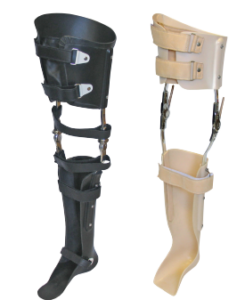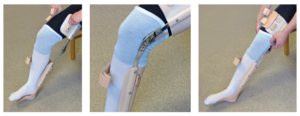What is a KAFO?
KAFO’s or ‘Knee Ankle Foot Orthoses’ are full leg splints. They are prescribed for a number of reasons, these include:
- To provide support to weakened or weakening joints and muscles.
- To realign some or all of the joints in the leg.
- To prevent movement which is unhelpful or painful.
- To provide protection.
How are they made?
KAFO’s can be made of different materials including thermoplastics, laminates or metal bands and leather. They are divided into a thigh section and an ankle foot section which are joined together by two metal sides and joints at the knee. The KAFO is held on by Velcro straps and is close fitting to ensure the correct control is achieved.

Thermoplastic KAFO
Plastic KAFO’s have a plastic section thigh section and an Ankle Foot Orthosis which is worn against the back of your leg and foot and inserts into your shoe.
Metal and leather KAFO
Metal and leather KAFO’s have a leather covered band one around your thigh and one around your calf. The sides will attach into the heel of your shoe.
What should be worn under the KAFO?
You should wear long cotton socks or tights under the KAFO which are:
- Well fitting.
- Un-patterned.
- Pulled up firmly to eliminate creases.

Putting on your KAFO:
- It is best to put the KAFO on whilst sitting or lying down. Place your leg into the KAFO ensuring your heel is right to the bottom and at the back of the AFO or shoe.
- Ensure the knee joints are roughly level with the middle of your knee cap.
- Finally fasten the straps firmly.
- If you have a metal and leather KAFO it is usually easiest to leave it connected to your shoe and put them both on at the same time.
What about footwear?
- Your KAFO should be worn with ordinary footwear with a fastening, i.e. laces or Velcro.
- Look for shoes which have a low opening as this will help to put them on.
- Shoes with removable insoles can offer extra depth to accommodate the KAFO.
- Avoid high heels.
How long should they be worn?
At first, the KAFO may feel uncomfortable so you should gradually build up the amount of time you wear it each day.
Your orthotist will tell you how long you should build up to, or what activities to wear it for.
What about red marks?
- You should check the skin where the KAFO has been in contact every time you take the KAFO off.
- It is normal to see red marks where pressure has been applied.
- These should disappear within 30mins.
- If you notice any sores or blistering you should stop using the KAFO and contact your orthotist for advice as it may need adjusting.
Care of your KAFO:
It is important to keep your KAFO well maintained.
- Clean it with a damp cloth and towel dry.
- Keep it away from direct heat.
- If the Velcro straps, linings or padding become worn contact the orthotic department for repair.
- Attend the orthotic department for knee joint service annually or as instructed by your orthotist.
DO NOT TRY TO ADJUST THE KAFO YOURSELF
The Knee Ankle Foot Orthosis supplied is considered the most appropriate for your condition. You may discuss alternative orthoses with the orthotist.
Review Procedure
Please follow the review advice given to you by the orthotist.
If you require an appointment before this time, please contact the orthotic department.
Orthotic Department tel:01582 497198.
Annual Service
The Orthotics department will tell you when your KAFO will require an annual service.
Please contact the Orthotic department to arrange a mutually convenient appointment.
